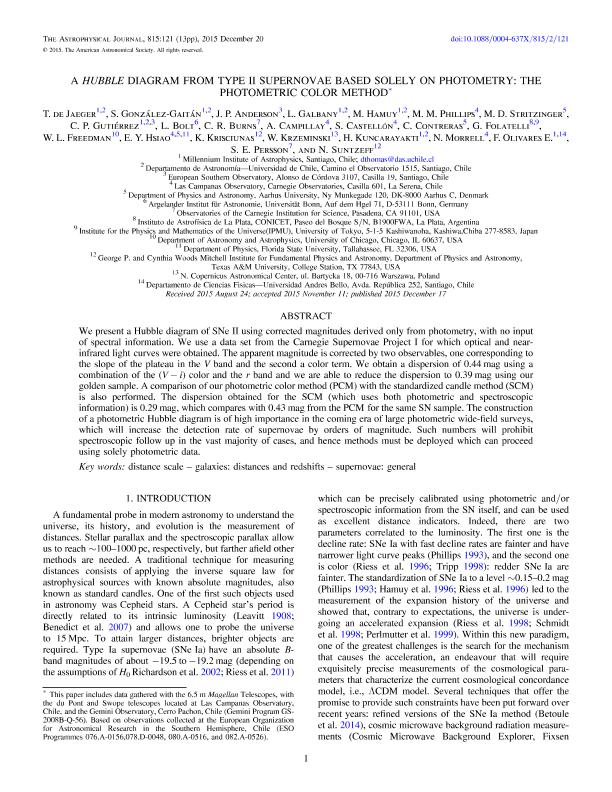Mostrar el registro sencillo del ítem
dc.contributor.author
De Jaeger, T.
dc.contributor.author
González Gaitán, S.
dc.contributor.author
Anderson, J. P.
dc.contributor.author
Galbany, L.
dc.contributor.author
Hamuy, M.
dc.contributor.author
Phillips, M. M.
dc.contributor.author
Stritzinger, M. D.
dc.contributor.author
Gutiérrez, C. P.
dc.contributor.author
Bolt, L.
dc.contributor.author
Burns, C. R.
dc.contributor.author
Campillay, A.
dc.contributor.author
Castellón, S.
dc.contributor.author
Contreras, C.
dc.contributor.author
Folatelli, Gaston

dc.contributor.author
Freedman, W. L.
dc.contributor.author
Hsiao, E. Y.
dc.contributor.author
Krisciunas, K.
dc.contributor.author
Krzeminski, W.
dc.contributor.author
Kuncarayakti, H.
dc.contributor.author
Morrell, N.
dc.contributor.author
Olivares E. F.
dc.contributor.author
Persson, S. E.
dc.contributor.author
Suntzeff, N.
dc.date.available
2017-03-13T18:38:56Z
dc.date.issued
2015-12
dc.identifier.citation
De Jaeger, T. ; González Gaitán, S.; Anderson, J. P. ; Galbany, L.; Hamuy, M.; et al.; A Hubble diagram from type II supernovae based solely on photometry: the photometric color method; Iop Publishing; Astrophysical Journal; 815; 2; 12-2015; 121-143
dc.identifier.issn
0004-637X
dc.identifier.uri
http://hdl.handle.net/11336/13772
dc.description.abstract
We present a Hubble diagram of SNe II using corrected magnitudes derived only from photometry, with no input of spectral information. We use a data set from the Carnegie Supernovae Project I for which optical and near-infrared light curves were obtained. The apparent magnitude is corrected by two observables, one corresponding to the slope of the plateau in the V band and the second a color term. We obtain a dispersion of 0.44 mag using a combination of the (V - i) color and the r band and we are able to reduce the dispersion to 0.39 mag using our golden sample. A comparison of our photometric color method (PCM) with the standardized candle method (SCM) is also performed. The dispersion obtained for the SCM (which uses both photometric and spectroscopic information) is 0.29 mag, which compares with 0.43 mag from the PCM for the same SN sample. The construction of a photometric Hubble diagram is of high importance in the coming era of large photometric wide-field surveys, which will increase the detection rate of supernovae by orders of magnitude. Such numbers will prohibit spectroscopic follow up in the vast majority of cases, and hence methods must be deployed which can proceed using solely photometric data.
dc.format
application/pdf
dc.language.iso
eng
dc.publisher
Iop Publishing

dc.rights
info:eu-repo/semantics/openAccess
dc.rights.uri
https://creativecommons.org/licenses/by-nc-sa/2.5/ar/
dc.subject
Distance Scale
dc.subject
Galaxis
dc.subject
Distances
dc.subject
Supernovae
dc.subject
Redshift
dc.subject.classification
Astronomía

dc.subject.classification
Ciencias Físicas

dc.subject.classification
CIENCIAS NATURALES Y EXACTAS

dc.title
A Hubble diagram from type II supernovae based solely on photometry: the photometric color method
dc.type
info:eu-repo/semantics/article
dc.type
info:ar-repo/semantics/artículo
dc.type
info:eu-repo/semantics/publishedVersion
dc.date.updated
2017-03-07T15:21:35Z
dc.journal.volume
815
dc.journal.number
2
dc.journal.pagination
121-143
dc.journal.pais
Estados Unidos

dc.journal.ciudad
Londres
dc.description.fil
Fil: De Jaeger, T. . Universidad de Chile; Chile
dc.description.fil
Fil: González Gaitán, S.. Universidad de Chile; Chile
dc.description.fil
Fil: Anderson, J. P. . European Southern Observatory; Chile
dc.description.fil
Fil: Galbany, L.. Universidad de Chile; Chile
dc.description.fil
Fil: Hamuy, M.. Universidad de Chile; Chile
dc.description.fil
Fil: Phillips, M. M. . Carnegie Observatories. Las Campanas Observatory; Chile
dc.description.fil
Fil: Stritzinger, M. D.. Aarhus University; Dinamarca
dc.description.fil
Fil: Gutiérrez, C. P.. Universidad de Chile; Chile
dc.description.fil
Fil: Bolt, L.. Universität Bonn; Alemania
dc.description.fil
Fil: Burns, C. R. . Observatories of the Carnegie Institution for Science; Estados Unidos
dc.description.fil
Fil: Campillay, A.. Carnegie Observatories. Las Campanas Observatory; Chile
dc.description.fil
Fil: Castellón, S.. Carnegie Observatories. Las Campanas Observatory; Chile
dc.description.fil
Fil: Contreras, C.. Aarhus University; Dinamarca
dc.description.fil
Fil: Folatelli, Gaston. Consejo Nacional de Investigaciones Científicas y Técnicas. Centro Científico Tecnológico La Plata. Instituto de Astrofísica de La Plata; Argentina. University of Tokyo; Japón
dc.description.fil
Fil: Freedman, W. L. . University Of Chicago; Estados Unidos
dc.description.fil
Fil: Hsiao, E. Y. . Carnegie Observatories. Las Campanas Observatory; Chile
dc.description.fil
Fil: Krisciunas, K.. Texas AyM University; Estados Unidos
dc.description.fil
Fil: Krzeminski, W.. N. Copernicus Astronomical Center; Polonia
dc.description.fil
Fil: Kuncarayakti, H.. Universidad de Chile; Chile
dc.description.fil
Fil: Morrell, N.. Carnegie Observatories. Las Campanas Observatory; Chile
dc.description.fil
Fil: Olivares E. F.. Universidad de Chile; Chile
dc.description.fil
Fil: Persson, S. E. . Observatories of the Carnegie Institution for Science; Estados Unidos
dc.description.fil
Fil: Suntzeff, N.. Texas AyM University; Estados Unidos
dc.journal.title
Astrophysical Journal

dc.relation.alternativeid
info:eu-repo/semantics/altIdentifier/url/https://doi.org/10.1088/0004-637X/815/2/121
dc.relation.alternativeid
info:eu-repo/semantics/altIdentifier/doi/http://dx.doi.org/10.1088/0004-637X/815/2/121
Archivos asociados
